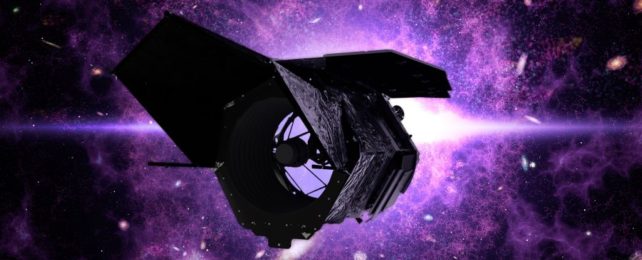For over a century, astronomers have known that the Universe has been expanding since the Big Bang. For the first 8 billion years, the expansion rate was relatively consistent since it was held back by the force of gravitation.
However, thanks to missions like the Hubble Space Telescope, astronomers have since learned that roughly 5 billion years ago, the rate of expansion has been accelerating.
This led to the widely-accepted theory that a mysterious force is behind the expansion (known as Dark Energy), while some insist that the force of gravity may have changed over time.
This is a contentious hypothesis since it means that Einstein's General Theory of Relativity (which has been validated nine ways from Sunday) is wrong.
But according to a new study by the international Dark Energy Survey (DES) Collaboration, the nature of gravity has remained the same throughout the entire history of the Universe.
These findings come shortly before two next-generation space telescopes (Nancy Grace Roman and Euclid) are sent to space to conduct even more precise measurements of gravity and its role in cosmic evolution.
The DES Collaboration comprises researchers from universities and institutes in the US, UK, Canada, Chile, Spain, Brazil, Germany, Japan, Italy, Australia, Norway, and Switzerland.
Their third-year findings were presented at the International Conference on Particle Physics and Cosmology (COSMO'22), which took place in Rio de Janeiro from August 22nd to 26th.
They were also shared in a paper titled "Dark Energy Survey Year 3 Results: Constraints on extensions to Lambda CDM with weak lensing and galaxy clustering" that appeared in the American Physical Society journal Physical Review D.
Einstein's General Theory of Relativity, which he finalized in 1915, describes how the curvature of spacetime is altered in the presence of gravity.
For over a century, this theory has accurately predicted almost everything in our Universe, from Mercury's orbit and gravitational lensing to the existence of black holes.
But between the 1960s and 1990s, two discrepancies were discovered that led astronomers to wonder if Einstein's theory was correct. First, astronomers noted that the gravitational effects of massive structures (like galaxies and galaxy clusters) did not accord with their observed mass.
This gave rise to the theory that space is filled with an invisible mass that interacts with 'normal' (aka. 'luminous' or visible) matter via gravity. Meanwhile, the observed expansion of the cosmos (and how it is subject to acceleration) gave rise to the theory of Dark Energy and the Lambda Cold Dark Matter (Lambda CDM) cosmological model.
Cold Dark Matter is an interpretation where this mass is composed of large, slow-moving particles while Lambda represents Dark Energy. In theory, these two forces constitute 95 percent of the total mass-energy content of the Universe, yet all attempts to find direct evidence of them have failed.
The only possible alternative is that Relativity needs to be modified to account for these discrepancies. To find out if that's the case, members of the DES used the Victor M. Blanco 4-meter Telescope at the Cerro Telolo Inter-American Observatory in Chile to observe galaxies up to 5 billion light-years away.
They hoped to determine if gravity has varied over the past 5 billion years (since the acceleration began) or over cosmic distances. They also consulted data from other telescopes, including the ESA's Planck satellite, which has been mapping the Cosmic Microwave Background (CMB) since 2009.
They paid close attention to how the images they saw contained subtle distortions due to dark matter (gravitational lenses). As the first image released from the James Webb Space Telescope (JWST) illustrated, scientists can infer the strength of gravity by analyzing the extent to which a gravitational lens distorts spacetime.
So far, the DES Collaboration has measured the shapes of over 100 million galaxies, and the observations all match what General Relativity predicts. The good news is that Einstein's theory still holds, but this also means that the mystery of Dark Energy persists for the time being.
Luckily, astronomers will not have to wait long before new and more detailed data is available. First, there's the ESA's Euclid mission, slated for launch by 2023 at the latest. This mission will map the geometry of the Universe, looking 8 billion years into the past to measure the effects of Dark Matter and Dark Energy.
By May 2027, it will be joined by NASA's Nancy Grace Roman Space Telescope, which will look back over 11 billion years. These will be the most detailed cosmological surveys ever conducted and are expected to provide the most compelling evidence for (or against) the Lambda-CDM model.
As study co-author Agnès Ferté, who conducted the research as a postdoctoral researcher at JPL, said in a recent NASA press release:
"There is still room to challenge Einstein's theory of gravity, as measurements get more and more precise. But we still have so much to do before we're ready for Euclid and Roman. So it's essential we continue to collaborate with scientists around the world on this problem as we've done with the Dark Energy Survey."
In addition, observations provided by Webb of the earliest stars and galaxies in the Universe will allow astronomers to chart the evolution of the cosmos from its earliest periods. These efforts have the potential to answer some of the most pressing mysteries in the Universe.
These include how Relativity and the observed mass and expansion of the Universe coincide but could also provide insight into how gravity and the other fundamental forces of the Universe (as described by quantum mechanics) interact – a Theory of Everything (ToE).
If there's one thing that characterizes the current era of astronomy, it is the way that long-term surveys and next-generation instruments are coming together to test what has been the stuff of theory until now.
The potential breakthroughs that these could lead to are sure to both delight and confound us. But ultimately, they will revolutionize the way we look at the Universe.
This article was originally published by Universe Today. Read the original article.
